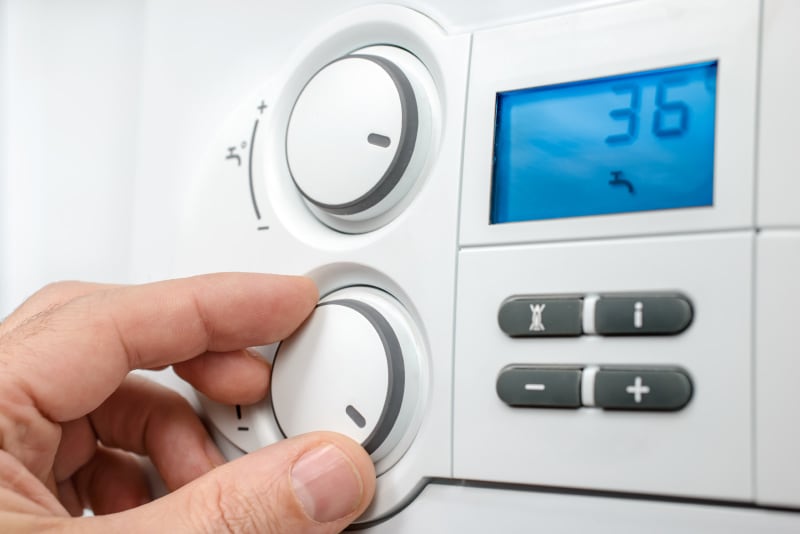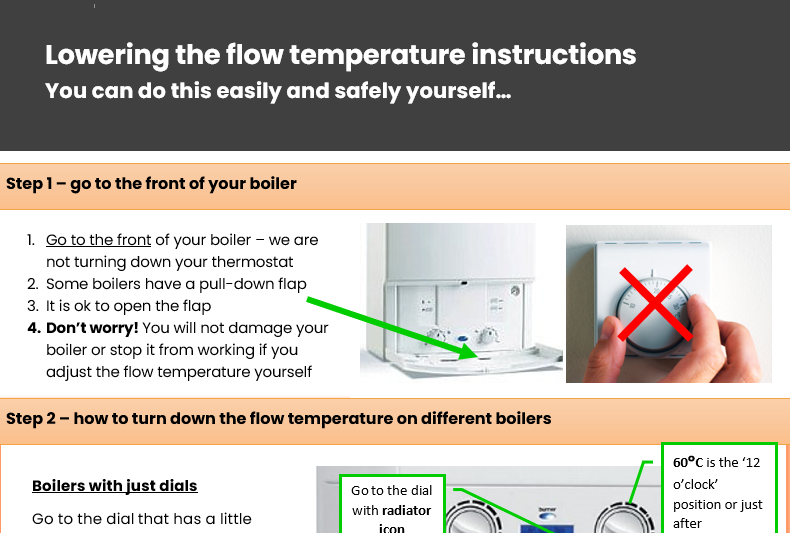Save 9% in gas use, by turning down the 'flow' temperature
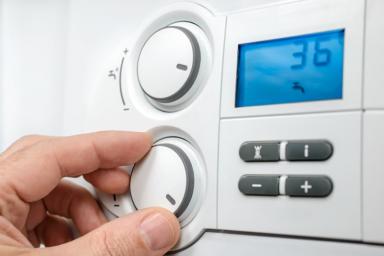
A recent study by Nesta* found that households can save around 9% in gas just by dialling down the heating flow temperature on their condensing combi boiler. To be clear, this is not turning down your thermostat.
Nearly all combi boilers are not optimised to run as efficiently as they should, which increases household gas bills and emits more carbon. Reducing the operating temperature for heating will help your boiler run more efficiently without reducing your comfort. We help you check if you have the right sort of boiler and show you how to make this simple change. (NB turning down your heating flow temperature is separate to setting your hot water temperature, but we cover that too - see section 11.)
Video and illustrated leaflet now available: if you prefer to watch a video or request a free PDF leaflet that you can print off and/or email to others you can do so via our dedicated Mission page, where you can also find other ways of optimising your combi boiler to reduce your gas bills further.
Contents
- What does 'turning down the flow temperature' mean?
- What type of boiler do I need?
- How do I reduce the flow temperature?
- What is the correct condensing boiler temperature setting?
- Can I use trial and error?
- Will I notice any changes in my heating system?
- What if I have a health condition?
- Where can I get more help with this?
- Why have I not been advised about this before?
- Is there anything else I can do to improve efficiency?
- What temperature should my combi be set at for hot water?
- I have a hot water cylinder, what do I do?
- Test if you are ready for a heat pump
1) What does 'turning down the flow temperature' mean?
The 'flow temperature' is the temperature your boiler heats up the water to before sending it off to your radiators. Most gas boilers are set up to operate at what is called 80/60 flow and return temperatures. This means the boiler heats up the water (called ‘the flow’) to 80°C. The water returns to the boiler after travelling around all your radiators (called ‘the return’) at 60°C, having given off 20°C to the room.
However 80/60 flow and return temperatures are too high for a condensing gas boiler to achieve the A-rated efficiencies shown 'on-the-box'. It is a little know fact that modern boilers have a variable efficiency between A-E, in other words they are not A-rated out of the box. Studies have found most to be C-E-Rated in the home, equivalent to just 75-85% efficiency.
Your installer should have reduced the flow temperature to give the boiler a chance to run in what is known as 'condensing mode' as much as possible. This is when it can recover the heat that was previously lost through the flue on old style boilers.
At 70/50°C the boiler will start to operate in condensing mode. Only when the flow temperature is 60°C or lower will the boiler recover enough heat to reach its higher efficiency potential.
2) What type of boiler do I need?
You will need to have a condensing combi boiler, i.e. a boiler that produces your heating and hot water. You will have a combi boiler if you do not have a hot water cylinder. It will definitely be a condensing boiler if it was fitted in the last 16 years. A condensing boiler will also have a white plastic pipe underneath the boiler (although it can be grey or black).
What if I have a hot water cylinder? Advice is different for boilers that work with a hot water cylinder. See section 12 below.
3) How do I reduce the flow temperature?
You need to go to the controls on front of your boiler. To be clear this is not your room thermostat, this sets the flow temperature for the boiler. The way in which you adjust the flow temperature and the display information available varies a great deal. Three common are examples are given below:
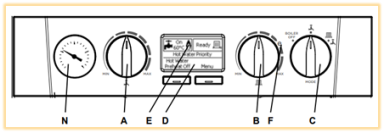
One or two dials
Most combi boilers have two dials: one for heating (usually with a little radiator icon over it) and one for hot water (with a little tap icon). Some only have one dial but it is usually for the heating flow temperatures. We've had lots of feedback on dials that do not provide the actual temperature setting. Some like Worcester are numbered 1-6, some have dashed lines and others a curved line of increasing thickness. Some user manuals do provide additional information.
If you have to work it out manually, then as a guide most boilers have flow temperatures that operate between 30°C-80°C. Which means 60°C will be about half way or the No. 3. We suggest setting to No.3 to begin with or at the half way mark (12 o'clock position). If there is a 'e' on the dial (not always present) it stands for 'economy' and will be around 70°C, so actually not that economical. Our advice is to ignore it. NB we are not adjusting your flow temperature for hot water (with tap icon) - see section 11 below.
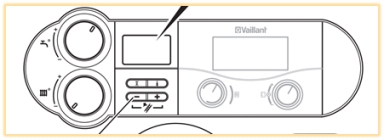
Dials with digital displays
Some boilers have a dial but the flow temperature figure will appear in the digital display. Turn the dial with the radiator icon down until you reach 55-60°C. NB the boiler may not operate at the temperature set, rather it will target that temperature but reduce further when not needed. Our advice is not to get too distracted by what it does after you have turned the dial. NB we are not adjusting your flow temperature for hot water (with tap icon) - see section 11 below.
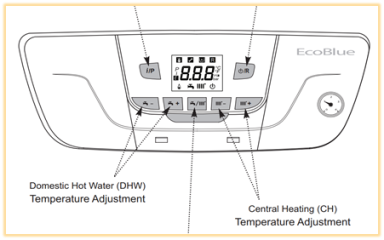
Digital displays with up and down buttons
Some newer boiler models have digital displays with up and down buttons or plus (+) and minus (-) buttons. You simply adjust the flow temperature via the 'down' or 'minus' button and the flow temperature figure will show in the digital display. Sometimes you have to press and hold a menu button to bring up the flow temperature, reduce it to 60°C, then press the menu button again to set (like setting the time on a cooker). NB we are not adjusting your flow temperature for hot water (with tap icon) - see section 11.
4) What is the correct condensing boiler temperature setting?
The correct temperature setting for heating on a combi boiler is 'as low as possible', but as a guide most older homes can run their heating systems at 60°C and newer homes at 50-55°C. They start to reach their very highest efficiency potential at 45°C flow temperature or lower, but this can be too low for older properties.
Ultimately how low you can turn your flow temperature down will depend on the size of your radiators, how well insulated your home is and your thermostat temperature.
Lower flow temperatures need more surface area of radiator to meet your desired room temperature; hence why we need much larger radiators for an air source heat pump. The good news is that most radiators are bigger than they need to be as the industry has sized based on guesswork or used basic online calculators that almost always overcompensate. We recommend trying it at 60°C. If you have a home built after 2010, try 50°C.
For homes with modern double glazing, cavity walls and good levels of loft insulation you should be able to drop your flow temperature down with no impact on comfort. Even older homes, particularly terraced houses, will be able to do this if they have been modernised and draft proofed.
Keep lowering the flow temperature!
60°C (or 50°C in a modern home) is the temperature you need on a very cold day. During the milder winter months you will be able to go lower and this will help the boiler run even more efficiently.
Older homes with double glazing and loft insulation:
Oct/Nov: 50°C
Dec: 55°C
Jan/Feb: 60°C
Mar: 55°C
April: 50°C
Modern homes built after 2010 or very well insulated try this pattern:
Oct/Nov: 45°C
Dec: 50°C
Jan/Feb: 55°C
Mar: 50°C
April: 45°C
5) Can I use trial and error?
Yes you can. Without an accurate heat loss calculation and radiator sizing exercise, it will be a matter of turning down the flow temperature and testing it to see if your house stays warm. You can turn it down little by little, or turn it down a lot and notch it back up if it doesn’t seem warm enough. It may be that you can turn it down to below 60°C for most of the year but still need to notch it up in really cold weather.
6) Will I notice any changes in my heating system?
Yes. Your radiators will not feel so hot. This is a sign that the system is running a little cooler, which is what you are trying to achieve. Providing your home does not feel cold and you do not feel cold, the boiler and system are working correctly and more efficiently.
If you have your heating programmed to come on for a very limited amount of time, you may notice that it will take longer for your home to heat up. Many households are accustomed to short heat up times because they run so hot. Lower flow temperatures will mean slightly longer heat up times.
For those that have the heating on much of the day, you will move to lower temperatures for longer periods which will have a positive impact on fuel bills.
7) What if I have a health condition?
We would caveat the above advice for those with health conditions. Staying warm is very important and we would not wish you to risk your well being by adjusting your heating system on a trial and error basis.
8) Where can I get more help with this?
Try our How-To video which shows how to turn the flow temperature down on different types of combi boiler. For more information on your boiler you can look in the instruction manual. You can usually find your manual on-line if you search for the make and model of your boiler. To be totally sure you have the right manual, find the boiler's 'GC' number. Every boiler has one and its usually on the boiler's data-plate. It will start with GC followed by a 7 digit number.
Alternatively you can ring the manufacturer's technical helpline for customers. They will need the model or preferably the GC or serial number to help you with your particular boiler.
You can also ask your installer when you next have the boiler serviced. NB not all installers are familiar with condensing boiler technology, but should be able to assist with this function.
9) Why have I not been advised about this before?
A vast skills and knowledge gap (that dates back to 2005 when condensing gas boilers become mandatory) means 99% of installers do not understand how condensing gas boilers work and therefore cannot set them up to run as they were designed to. Installers have been let down and so have UK households. We have simply not benefited as much as we should have from this leap forward in boiler efficiency.
Part of our work is to educate households on their heating systems and help them get higher efficiencies from their existing boilers. The over-replacement of boilers is a problem in the UK. We want to see more existing boilers running optimally with small changes that reduce energy bills and our carbon footprint. A 15% efficiency improvement across all UK households is enough to heat every home in Wales for a year.
Finding skilled installers is also a struggle. We have spent a lot of time building a highly competent installer network**.
10) Is there anything else I can do to improve efficiency?
Yes lots. Lowering the flow temperature is just step 1. Most boilers are running 10-25% under their A-rated efficiency due to incorrect set up. A number of changes can be made to any boiler and heating system to tap latent efficiency. We help households invest in low cost efficiency measures to their existing boiler and heating system to harness untapped efficiency. To be clear we rarely advocate replacing a working, condensing boiler. We offer 1-2-1 help via our pioneering efficiency services to provide a bespoke specification for your boiler and system, visit How we work for more.
11) What temperature should my combi boiler be set at for hot water?
You can adjust your hot water temperature somewhat, but you must be mindful of legionella risks. Legionella is a bacteria that can occur in domestic hot water systems. It is more common in stored hot water, i.e. hot water cylinders, although still very rare (see section 12 for more on hot water cylinders).
There is a lower risk of legionella occurring in domestic dwellings that have a combi boiler (i.e. no hot water cylinder) and where there is daily usage of hot water. The HSE state that hot water outlets (taps and showers) should achieve 50-60°C. Depending on your levels of pipe insulation and length of the pipe runs, you may be able to set the hot water temperature on the boiler to 55°C, and possibly lower if you live in a modern flat or smaller modern home.
However, if you have had a cylinder removed it is important to check for 'dead legs' in the pipework. This is a length of pipe that has been capped off and goes nowhere. If it is over 150mm long it does pose a risk and you should keep your system at 60°C.
12) I have a hot water cylinder, what do I do?
If you have a hot water cylinder, you will have either a 'system' boiler or a 'conventional' boiler (aka heat-only or regular boiler) with a 'vented' or 'unvented' hot water cylinder. The HSE state that hot water must be stored in the cylinder at 60°C to kill legionella bacteria (which can be fatal for humans), which means flow temperatures should be 70°C to compensate for heat losses in the transfer of hot water to the cylinder.
In nearly all households the boiler can only supply one temperature, which has to be the higher temperature for hot water safety, i.e. 70degC. It is a sad fact that if you have a hot water cylinder the boiler it will almost NEVER condense! In other words, most boilers that work with a hot cylinder are no where near efficient.
What is the solution? The boiler needs to be set up with separate heating and hot water temperatures, a low efficient temperature for heating and a high safe temperature for hot water. Adapting your boiler so it can supply a lower flow temperature for heating (that you can adjust) requires boiler-specific advice and some minor works to your system. We can provide the correct advice for your boiler via our efficiency audit service.
To be clear, this approach does not suggest you throw out your hot water cylinder in favour of a combi. As we transition to low carbon heating solutions we will need our hot water cylinders once again. Rather the boiler needs to be set up correctly with the cylinder to get the best efficiencies for heating. Go to our latest blog on keeping your gas boiler and making it more efficient.
Is there anything I can do today? You can limit how often your cylinder comes on and make sure it is well insulated. Timing your boiler to once a day before you need it and making the hot water last will reduce how much energy you use eg take short showers. Hot water cylinders lose about 5-7degC over 12 hours so a full cylinder of hot water in the morning should still be hot at the end of the day. More hits and tips on our latest Quick wins to reducing your heating bill.
13) Test if you are ready a heat pump
If you can run your heating system at 45°C then your system will work with a heat pump without modification. If you have underfloor heating in large parts of your home; a home built in the last 10 years; or an older home that has been heavily insulated there is a good chance you can run your heating system low enough.
WARNING: many new build homes use 'microbore' pipework (instead of standard 15mm pipework you will have 10mm or even 8mm pipework) and it maybe too small to cope with lower flow temperatures. There are exceptions when it can work however.
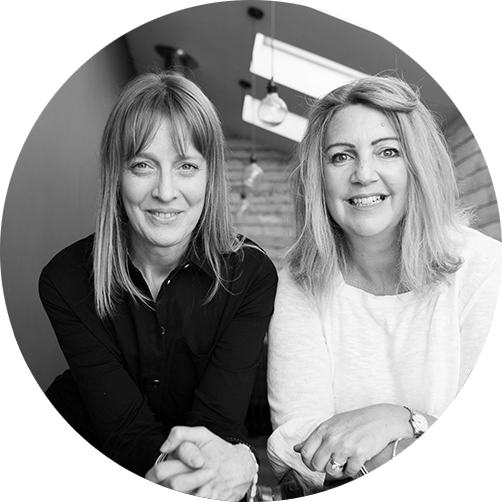
1-2-1 advice with our Efficiency Audit
More reads...
Guide to boiler efficiencies
99% of gas boilers are running below their A-rated efficiency, we explain why.
The real cost of boiler inefficiency
Soaring gas prices expose the real cost of poorly performing boilers.
References
*Nesta's study - Learn more
**Our Elite Installer Network - Learn more
***1-2-1 Advice on efficiency upgrades - How we work

